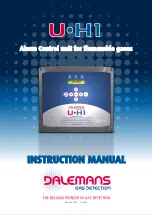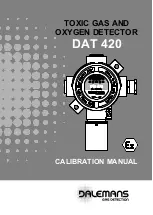
The detector assembly is simple and requires no tools, a properly assembled
detector is shown on the front cover of the user’s manual. Before assembling the
stems, make sure the clamp is unlocked by rotating it as shown in the picture. Next
push the spring buttons in and insert one stem into the other. Release the buttons
and they will lock in the holes. Next secure the clamp by turning it the other way until
it is hand tight. Do not over tighten the clamps or the screw securing the search coil.
The connecting cable should be secured with two rubber cable tie to the base of the
lower stem, and then wrapped around the stems. Doing this will prevent from creating loose loops of the
cable in the search coil area and protect the cable from pulling out from the search coil. The third rubber
cable tie should be used to attach the cable to the top of the detector, which will prevent the cable from
slipping downwards.
Be careful not to pull the cable too tight when inserting the plug into the
socket - as this may damage the cable.
See the photo on the front page for best practice. The armrest
is adjustable – first remove the screw, then move the armrest to the desired position and re-tighten the
screw.
NOTE: Try to avoid creating large loops of cable near the edges of the search coil, as this may result in
the detector giving false readings.
NOTE: When disassembling the detector, begin by unplugging the search coil from the socket and
loosen the cable wound around the stems. Once this is completed the rest of the detector may be
disassembled into its basic components. Finish by loosening the screw securing the search coil and fold
it together with the stem.
NOTE: The coil cable plug is protected by a silicon cover. This is there to prevent dirt and sand from
damaging the delicate, gold connector pins. If the plug is not in the socket, it should
always
have the
protective cover on.
NOTE: Cleaning the detector must be done using only water with soap on a damp sponge.
Do not use any solvents or petroleum products. Regularly clean the stems and clamps.
Use good quality alkaline or rechargeable batteries of well known brands. Do not mix new and
discharged batteries or regular ones with rechargeable ones. Used batteries must be removed from the
detector as soon as possible. Remember to remove the batteries from the detector if it is not going to be
used for an extended period of time. The warranty does not cover damage caused by leaking batteries
damaging the electronics.
In order to install the batteries, press the centre of the lid (2), unlock the clip
(1), and then remove the lid (2) as shown on the picture. After pulling out the battery
holder, insert the batteries as shown on the holder, remembering to check if the
polarity is correct. It is important to make sure that the spring is pressing the batteries
tightly. The holder can only be inserted into the detector one way – the shape
prevents it from being inserted the other way around.
NOTE: The detector has a battery indicator which monitors the batteries charge level. As the batteries
lose charge, the indicator bar will shorten. When the batteries need replacing the detector will turn off
automatically. It is not possible to turn on the detector if the batteries charge is
too low. As the battery reaches this level, the detector will make a sound of
decreasing frequency and the display will show a symbol of a crossed out
battery (see picture beside). The circuit monitoring the battery level shows
a charging level of 1.5 V for standard alkaline batteries. When using 1.2 V
rechargeable batteries the battery charge icon will never be full.
RUTUS
Argo NE
3
Содержание Argo NE
Страница 1: ......





































